Art World
10 Art Works Inspired by Great Literature for Your Summer Reading List
Summer reading recommendations, in images.

Summer reading recommendations, in images.

Naomi Rea

Do you have a pile of books gathering dust that you told yourself you’d finally get around to this summer? Well, don’t let it worry you. Rather than making it another daunting task, get inspired to pick up a great work of literature by considering the stimulation some of the world’s greatest artists have found in them.
Discover below some of the literary texts behind these enthralling works of art, and pack them for your holidays:
1. Jeff Wall, After “Invisible Man” by Ralph Ellison, the Prologue (1999-2000)
This painstakingly staged photograph by Canadian artist Jeff Wall was inspired by Ralph Ellison’s 1952 novel Invisible Man, which explores the struggle of an unnamed African American man in the mid twentieth century. In the prologue, he describes his basement room lit by 1369 light bulbs that are powered by illegally siphoned electricity. With one of his trademark elaborate sets, Wall has given detailed form to the image Ellison conjured in his mind. You don’t have to read the book (although it is highly recommended!) to understand the photograph; the protagonist muses “I am invisible, understand, simply because people refuse to see me.”
2. Sir John Everett Millais, Ophelia (1851-1852)
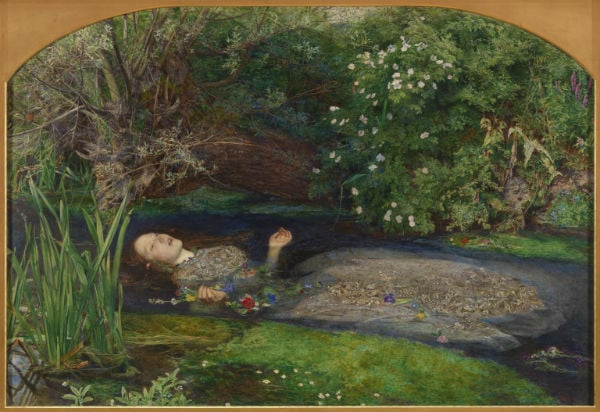
Sir John Everett Millais Ophelia (1851-2). Oil paint on canvas. ©Tate 2016.
This 19th century painting by Millais depicts Ophelia, a character from Shakespeare’s Hamlet. Driven mad when her father is murdered by her disturbed lover Hamlet, she is captured here singing shortly before she drowns. Millais’s work is admired for the realism of its landscape and is one of many portrayals of the ill-fated damsel.
“Fell in the weeping Brooke, her clothes spread wide,
And Mermaid-like, a while they bore her up,
Which time she chanted snatches of old tunes,
[…]
Till that her garments, heavy with her drink,
Pul’d the poor wretch from her melodious lay,
To muddy death.”
3. Salvador Dalí, Mad Tea Party (1969)
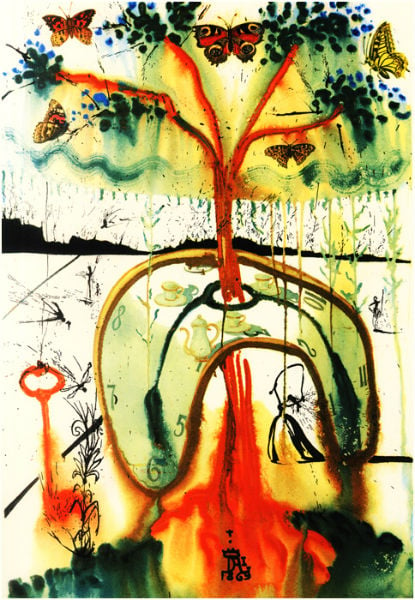
Salvador Dalí, Mad Tea Party (1969). Image courtesy William Bennet Gallery.
Dalí’s surrealist bent is a fitting match for illustrations to accompany Lewis Carroll’s equally hypnagogic Alice in Wonderland (1865). Mad Tea Party is one of a suite containing 12 heliogravures—one for each chapter of the book. The rarely seen illustrations are stunning, and draw you into the rabbit hole to a vibrant vision of Carroll’s captivating (and terrifying) world.
Images of the full suite have been digitised by the William Bennet Gallery.
4. John William Waterhouse, The Lady of Shalott (1888)
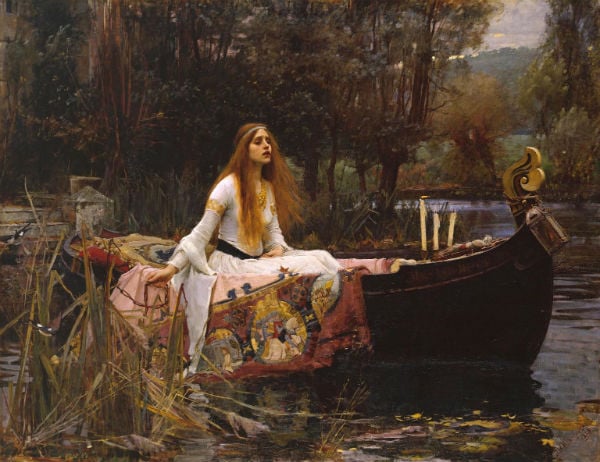
John William Waterhouse The Lady of Shalott (1888) Oil paint on canvas. © Tate 2016.
This oil painting is based on Tennyson’s 1832 ‘The Lady of Shalott’. The poem tells the tragic tale of an Arthurian maiden isolated in a tower, cursed to only ever see the world reflected through a mirror. When she one day glimpses Lancelot, she cannot resist looking at him directly, which causes the cursed mirror to crack. The painting (one of few Waterhouse ‘plein air’ paintings) illustrates her attempt to reach Camelot before the malediction kills her.
“And at the closing of the day
She loosed the chain, and down she lay;
The broad stream bore her far away,
The Lady of Shalott.”
The Lady of Shalott is on display at Tate Britain.
5. Elida Tessler, Dubling (2010)
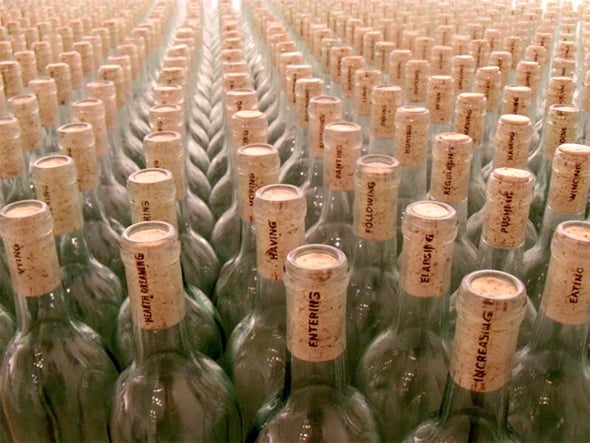
Elida Tessler Dubling>/i> (2010). Image courtesy elidatessler.com
DUBLING is an installation created from 4311 gerunds taken from James Joyce’s seminal modernist opus Ulysses. It features 4311 bottles stopped by corks stamped with the verbs, as well as 4311 postcards printed with images of Dublin’s river Liffey. Tessler’s installation gestures simultaneously to the river that is so central to the novel, Joyce’s pioneering stream-of-consciousness style, and the incredible metonymic power of objects like an empty wine bottle.
More images of the installation can be seen at Elida Tessler’s website.
6. Pablo Picasso, Don Quixote (1955)

Don Quixote (1955). Pablo Picasso.
This depiction of Cervantes’s effervescent Don Quixote de la Mancha and companion Sancho Panza is stylistically very different to Picasso’s earlier Blue, Rose, and Cubist periods but it is no less for it. The simple bold lines manage to capture the sense of ridiculousness of the errant duo’s quest as well as the accompanying exhaustion. The static image is somehow full of movement; horse and donkey restless, hot sun beating down, iconic windmills revolving slowly.
The sketch Don Quixote appeared in the August 18–24 issue of the French weekly journal Les Lettres Françaises in 1955.
7. David Hockney, Myself and My Heroes (1962)
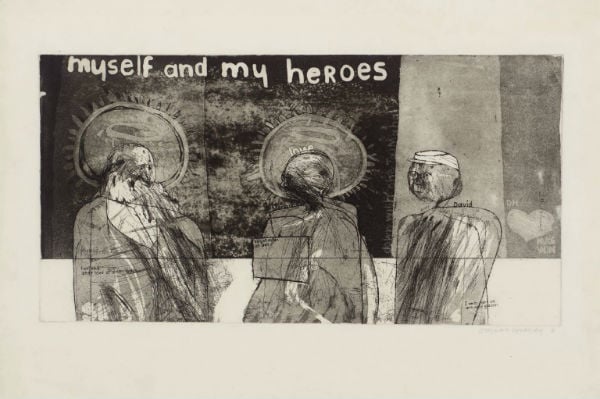
David Hockney Myself and My Heroes (1962). (c) David Hockney. Photo courtesy Tate.
Myself and My Heroes features a young Hockney slouched next to two of his idols: American poet Walt Whitman and Mahatma Ghandi. Inscribed above the haloed Whitman is the line “For the dear love of comrades” from his poem “I Hear It Was Charged Against Me”. Conversely, inscribed above Hockney’s self portrait are the words “I am 21 years old and wear glasses.” The self-deprecating and humorous tone is typical of Hockney and the sentiment relatable to many young artists who might also feel the weight of expectation from the greats that came before them.
8. Charles Demuth, I Saw the Figure 5 in Gold (1928)
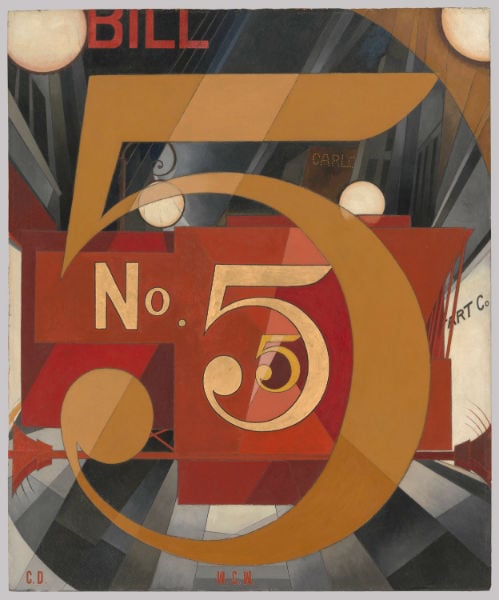
Charles Demuth I Saw the Figure 5 in Gold(1928). Charles Demuth. Oil, graphite, ink, and gold leaf on paperboard. 35 1/2 x 30 in. Alfred Stieglitz Collection, 1949.
I Saw the Figure 5 in Gold is one of Charles Demuth’s series of eight abstract portraits of friends. This one represents poet William Carlos Williams through images popularly associated with him; the initials W.C.W., the names “Bill,” and “Carlos” as well as an allusion to Williams’s poem “The Great Figure” in which a fire truck emblazoned with the number 5 rumbles through a dark city.
9. René Magritte, Domain of Arnheim (1962)
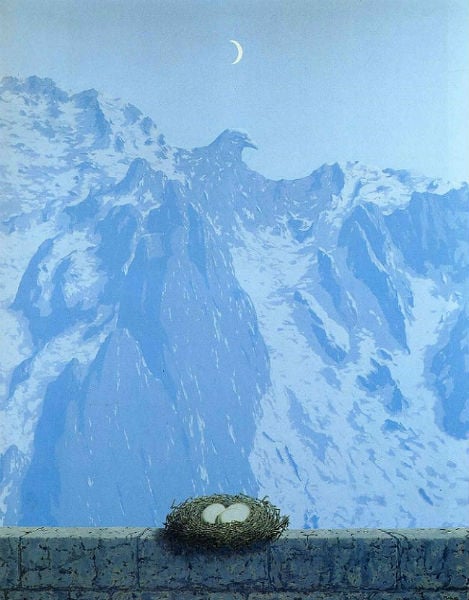
Rene Magritte, Domain of Arnheim (1962). Image courtesy renemagritte.org
In Edgar Allen Poe’s story The Domain of Arnheim, the American master of dark romanticism writes “no such combination of scenery exists in nature as the painter of genius may produce.” Magritte’s own Domain of Arnheim is his take on the ideal domain that can be forged in the mind’s eye and is imagined by Poe in the story.
10. William Kentridge, Ubu Tells the Truth (1997)
Kentridge’s Ubu Tells the Truth is a short dramatic film that melds documentary footage of South African state police charging unarmed apartheid protesters together with photographs, moving puppets, and violent animated drawings. The film was originally created for the multi-media theater work Ubu and the Truth Commission (1997), which was loosely modeled on and alludes to the proto-absurdist play Ubu Roi (1896) by French playwright Alfred Jarry. It implicates everyone in the human rights abuses during the apartheid era, the institutions that enabled it, bystanders guilty through inaction, not even the viewer is spared from guilt.